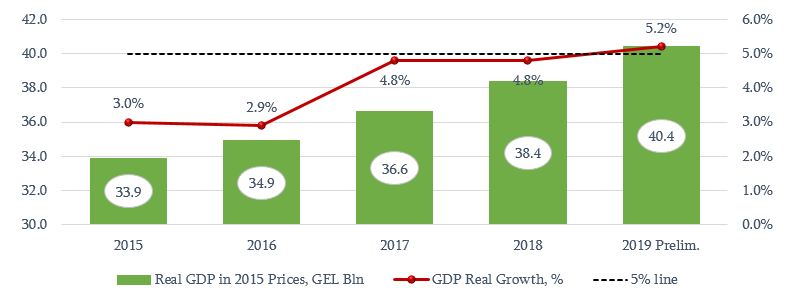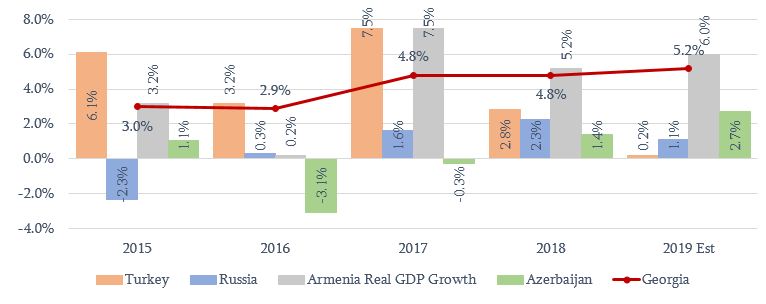Resume: The year 2012 was the last time (including 2018) when Georgia’s economic growth did exceed 5% (6.4%) after data verification. Of the period 2013-2018, Georgia’s highest economic growth rate was registered in 2017 and 2018 where in both cases it was 4.8%. In regard to 2019, only the preliminary estimate for economic growth is currently available and constitutes 5.2% according to the National Statistics Office of Georgia. If the aforementioned figure is kept over 5% after data verification, that will be the first case in the last seven years when Georgia’s economic growth reaches the threshold named by the Minister of Finance, or exceeds it. Therefore, Ivane Machavariani’s statement that Georgia’s economy has been growing by 5% does not correspond to the reality for 2018 and only the preliminary figure is available for 2019, which is currently over 5%, although it is uncertain whether or not that figure will remain after verification.
In regard to the part of the statement which deals with the comparison at a regional level, Mr Machavariani’s statement is a lie. Although the term ‘region’ is somehow indefinite in itself since the countries comprising the group and the principles upon which it is created are usually unknown. However, it is certain that Georgia’s region certainly includes its neighbour countries at the very least – Azerbaijan, Armenia, Russia and Turkey. Of Georgia’s neighbour countries, Armenia had a higher economic growth rate as compared to Georgia in 2017 and 2018 by 2.7 and 0.4 percentage points, respectively, whilst Georgia’s economic growth rate was 4.8% in both years.
In accordance with the International Monetary Fund, Georgia’s economic growth forecast for 2019 is 4.6%. In fact, according to the National Statistics Office of Georgia’s preliminary data, Georgia’s economic growth rate in 2019 was 5.2%. In the same period, according to the International Monetary Fund, Armenia’s economic growth rate is forecast at 6%. Speaking of factual figures, Armenia’s economic activity growth rate was 7.8% according to the Statistical Committee of the Republic of Armenia and this current information. This figure is not similar to economic growth, although historically it only marginally differs from the economic growth percentage figure. Taking this into account, Armenia’s economic growth rate for 2019 most likely will exceed the 6% threshold forecast and will come closer to the 7.8% indicator of the economic activity index. Therefore, even by the most conservative assessment, Armenia’s economic growth is higher as compared to Georgia’s in 2019. The economic growth rates for other neighbour countries for 2018-2019 are substantially lower as compared to Georgia’s and Armenia’s economic growth rates.
Analysis
The Minister of Finance of Georgia, Ivane Machavariani, in his interview with the media stated (from 3:16) that Georgia’s economy has been growing for more than 5% and this is the best performance in the region.
To analyse the extent to which the statement corresponds to reality, of importance is to define what Mr Machavariani implies in using the term ‘region.’ The term is somehow indefinite in itself since the countries comprising the group and the principles upon which it is created are usually unknown. However, it is certain that Georgia’s region certainly includes its neighbour countries at the very least – Azerbaijan, Armenia, Russia and Turkey. It is also clear from the statement that Mr Machavariani refers to data from the last two years. Therefore, the figures from 2018 and 2019 are of particular interest. Of these two figures, factual data for all of the countries are fully available only for 2018. The International Monetary Fund provides only forecasted figures for economic growth as of October 2019. In the case of Georgia, 2019’s economic growth preliminary figure is also available. FactCheck’s analysis is based upon these data.
The 2012 was the last time (including 2018) when Georgia’s economic growth did exceed 5% (6.4%) after figure adjustment whilst the country has never reached a 5% economic growth rate under the Georgian Dream’s rule. Of the period 2013-2018, Georgia’s highest economic growth rate was registered in 2017 and 2018 and in both cases it was 4.8%. In regard to 2019, only the preliminary estimate for economic growth is currently available and constitutes 5.2% according to the National Statistics Office of Georgia. If the aforementioned figure is kept over 5% after adjustment, it will be the first case in the last seven years when Georgia’s economic growth reached the threshold named by the Minister of Finance, or exceeded it.
Graph 1: Economic Growth and Real GDP Change Trend in Georgia

Source: National Statistics Office of Georgia
Graph 2: Economic Growth Rate in Georgia and Neighbour Countries

Source: International Monetary Fund, National Statistics Office of Georgia
In regard to the last two years per se, Georgia’s economic growth constituted 4.8% according to the final figures for 2018 which was 0.4 of a percentage point lower than Armenia’s economic growth rate. The economic growth rates for other neighbour countries are substantially lower. According to preliminary data of 2019, Georgia’s economy grew by 5.2% which exceeds the International Monetary Fund’s latest forecast figure (4.6%), although lags behind the figure forecast for Armenia by the International Monetary Fund. Armenia’s economic activity index for 2019, which is 7.8% according to the Statistical Committee of the Republic of Armenia, is also available and is substantially higher as compared to the preliminary figure for Georgia’s economic growth.
Chart 1: Difference between Armenia’s GDP Growth and Historical Figures of the Indicator of Economic Activity
|
2015 |
2016 |
2017 |
2018 |
|
|
Armenia - Real GDP Growth |
3.2% |
0.2% |
7.5% |
5.2% |
|
Armenia - Indicator of Economic Activity |
3.0% |
0.7% |
7.7% |
5.6% |
|
Difference |
0.2% |
-0.5% |
-0.2% |
-0.4% |
Source: Statistical Committee of the Republic of Armenia
Of importance is to clarify that the index of economic activity, which Armenia uses for a swift evaluation of economic growth, is not identical to the economic growth figure, although historically it is only marginally different from the actual figures for economic growth. Therefore, Armenia’s economic growth rate for 2019 will most likely exceed the forecast of 6% and be closer to the 7.8% figure of the economic activity index. Therefore, according to the most conservative assessments, Armenia will have a higher economic growth in 2019 as compared to Georgia.
Therefore, in 2015-2019, Georgia did not have the highest economic growth rate among neighbour countries, let alone the region, and one country at the very least has always been ahead of Georgia each year. In the same period, with 2016 being the only exception, Armenia had better growth figures. On top of that, Turkey had a higher economic growth rate than Georgia in 2015-2017. Turkey is an economically developed country with more difficulty to achieve an economic growth rate higher than Georgia which is economically less developed.








